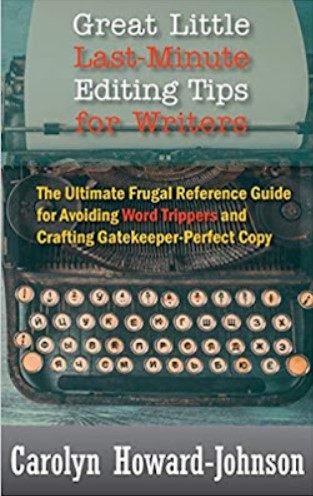Contributed by Carolyn Howard-Johnson
Most authors start dreaming about their book covers well before their manuscript is ready to publish. They start paying attention to what they encounter of the internet, which is often more disinformation than something they can or should use. One of the least helpful tells them that if they are going the traditional route, they should expect their publisher will not welcome their ideas or expertise (if any exists) to be used under their trademark. In fact, an effort on the part of the author will be an annoyance. Basically, they are told to butt out. Actually, the professional thing an author should do when they have a question is to ask—in the publishing process or—even better—in the contract-signing process.
My series of books for writers is a case where these naysayers were wrong. The publisher of Modern History Press made an effort to work with the book cover designer I used when I was self-publishing the series. We ended up with his designer and both publisher and designer accepted most of my suggestions or helped me understand why it wasn’t viable. In fact, occasionally they asked me for ideas or suggestions.
That is the reason authors—no matter how they hope to publish or how they end up publishing—will benefit if they start considering what their book cover should look like beyond what they see in their dreams.
Here are five things that an author can do to better prepare them for whatever role they play in the publishing process:
1. We can learn a lot about what makes a good book cover by just looking at the best of them--in airport bookstore windows and in our favorite bookstores.
2. We can learn a lot about what not to do by looking at book covers on Amazon where they are often only thumbnail size. I got a reminder about the importance of bookstores as I was scrolling through the books offered on an online book promotion service as I was trying to decide which books to retweet to my 40,000 plus publishing industry followers. I had to bypass many that might have otherwise worked for me but for lack of a prominent author's name on the cover. A cover must feature the name of the author big enough to be seen from a distance or in an image shrunk to accommodate the layout needed for online bookstores’ formats. That author name should be defined by color, outline, font style and more to be read. You’ll see some with the authors’ name in three-dimensional gold foil! Keep in mind you, the author, may one day be a star and it will be your name people remember, not necessarily the title of the book.
3. Even poetry and fiction authors should watch how poorly (and well!) some book covers use subtitles. It’s a good idea to jot down ideas that occur to you and put them into Notes or some other file.
4. Pay attention to the way front and back covers blend into the design of the spine. Having a hard delineation for what can be an imaginary line can cause big problems for a printer. (You may end up publishing independently and will be ahead of the game if you’re aware of this before your select your professional designer. You will be her or his partner and boss.
5. Pay attention to the covers of already-published books in your genre. It will teach you what you like and what to avoid.

So here is the new book cover of my recently published second edition of my booklet "Great Little Last Minute Editing Tips for Writers" (Modern History Press). I broke the "rules" and suggested a larger author name for my problematical name, a very, very long one. I quickly learned, all my “advisors” had been wrong. Victor Volkman, the publisher, was able to magically improve it by using what is widely regarded as the most easily read font of all, Times New Roman, using more contrast in color, and choosing a font that doesn't take up a lot of space—that is the letters are naturally narrower than in some other fonts. And he did it by using a readily available font—no special, expensive font design needed! And we were able to keep the retail price of the book down by using an appropriate image from an online catalog. They are sometimes reasonably priced, but they are often free. You’ll probably have to poke around a bit on image services to find the perfect one for your book. Note: I am fussy about what I called “canned images.” Some authors select something that other authors found useful, many others. Pay attention to books in your genre that have already been published. Now you can do this for the next book you publish with Kindle Direct Publishing or anywhere else that offers handy (and frugal!) cover templates. Remember what I tell my clients. "You may love Stephen King, but quick! Name all of his books. OK, name three." You can see that your readers remember you better than they remember your titles--even if you are as famous as King. This article was first published at: https://www.writersonthemove.com/2021/10/writers-on-move-contributor-carolyn.html ABOUT THE AUTHOR

Carolyn Howard-Johnson brings her experience as a publicist, journalist, marketer, and retailer to the advice she gives in her HowToDoItFrugally Series of books for writers and the many classes she taught for nearly a decade as instructor for UCLA Extension’s world-renown Writers’ Program. The books in her HowToDoItFrugally Series of books for writers have won multiple awards. That series includes The Frugal Book Promoter and The Frugal Editor which won awards from USA Book News, Readers’ Views Literary Award, the marketing award from Next Generation Indie Books and others including the coveted Irwin award.
I’m a working children’s ghostwriter, rewriter, editor, and coach. I can help turn your story into a book you’ll be proud to be the author of, one that’s publishable and marketable.
OTHER HELP I OFFER:
HOW TO WRITE A CHILDREN’S FICTION BOOK
A DIY book to help you write your own children’s book.
PICTURE BOOK AND CHAPTER BOOK COACHING
Four to ten-week coaching programs.
CREATING AN AUTHOR ONLINE PLATFORM
Step-by-step with a former WOW! Women on Writing author online platform instructor
You can contact me at: kcioffiventrice@gmail.com. Or give me a call at 347—834—6700. (Please leave a message- I’ll get back to you as soon as I can.)



Would love to hear your thoughts!